

Khamsa fi ainek (“Five [fingers] in your eye”).
—An Arabic saying to ward off the evil eye
Blessed Henna
Traditionally, henna was used as a form of sympathetic magic, whereby the appropriate symbol painted onto the skin would imbue the wearer with magical power.
In Morocco, the designs used are said to contain baraka. Baraka is an Arabic term meaning a blessing or flow of divine grace from God, giving the recipient good fortune or a reward for good deeds performed. If a person is said to “have baraka,” he is deemed to be a lucky person or protected by God. Barack Obama’s name is a Swahili derivative of the original Arabic. Baraka as a concept is deeply ingrained not only in designs on jewelry, textiles, or other manmade items, but it is said to reside in incenses and plants such as henna. The power is transferred to the object or user through artistry and symbolism. Moroccan henna designs tend to incorporate geometric shapes, eyes, hands, plants, and flowers. Similarly, in India, the symbols are used to placate the gods; the goddess Lakshmi, in particular, is said to dwell in henna designs.
Protection:
The Curse of the Evil Eye
One of the most common uses of symbols or amulets is that of protection. In practically every culture in the world, designs, motifs, and talismans have been created to protect us from evil. Whether that evil comes from a person, an animal, or a spirit, the premise is the same: to create a shield to absorb or bounce back the negative intent. Protective talismans collectively have a name—apotropaic (derived from the Greek apotrepein, “to ward off”).
In many countries, the term evil eye differs from how we might perceive it. The person giving the “eye” is not necessarily evil but is harboring jealousy or coveting something or someone; often they will look upon the item or person with envy while praising them. This is believed to cause misfortune for the “overlooked” one and should be prevented or cured by the use of amulets, symbols, spells, and prayers. The evil eye is blamed for anything from ill health, lost love, or the inability to bear children to the death of the household goat or fruit tree.
Examples of the use of talismans, charms, and spells for protection exist throughout the world; in Greece, secret prayers are said that are passed down through the generations for this specific purpose. Once the prayer has been recited, if the person has been afflicted by the evil eye, all present will begin to yawn; this is confirmed and followed by making the sign of the cross and spitting in the air three times. In Turkey and the Middle East, a nazar is frequently seen hanging on houses and boats and worn as jewelry. This disk or ball made of glass or stone consists of blue and white concentric circles that represent an eye, and it is believed to reflect evil intent back to the sender. Modernly, the nazar can be seen adorning anything from the tail of an airplane in the Turkish fleet to hanging on mobile phones or baby buggies! (See colour pages for examples of nazars.)
In Islamic and Jewish communities, a prominent protective amulet or design is the hamsa hand (also known as the khamsa or hamesh). It is a depiction of a hand; the word hamsa means “five” and therefore is represented by the fingers and thumb and is more commonly known as the Hand of Fatima in the Muslim faith and the Hand of Miriam by Jews. Often a blue eye will be placed in the middle of the hand to deflect evil. The Jewish culture also considers that fish are immune to the influence of the evil eye, and so the symbol is also frequently depicted on the hamsa.
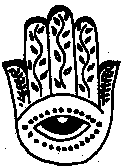
A hamsa hand design to ward off the evil eye
The people of ancient Rome had a slightly more risqué charm to chase away evil intentions: a phallic image called a fascinum (derived from the Latin fascinare) was used literally to fascinate and divert the evil eye. The cornicello, cornetti, or “little horn” is a symbol that was often seen worn as a pendant by males, usually made from gold, silver, or red coral. It is an elongated, gently twisted horn shape (often mistaken for a sperm) reputed to represent a sexual organ that would distract the sorcerer from casting their spell. There was also the belief that the evil eye could dry up liquids, and so the male sexual member could seek refuge in the moistness of the female vagina. This may have led to the hand gesture of the clenched fist with the thumb protruding between the index and middle finger, representing the penis within the vagina. This gesture was not only used by the Roman people but was incorporated into sculpture and made into amulets engraved with magical symbols. Modernly, these charms are still carried by people in countries such as Latin America, where it is viewed as a symbol of good fortune.
Young children have often been seen as being very vulnerable to the evil eye, and in many countries they are protected with amulets, symbols, and/or henna. In Mexico, Latin America, and in Jewish faiths, they are given a bracelet with a bead painted like an eye to repel envy or malice. Because children are believed to be pure and innocent at birth, it is very important that they are protected immediately, and in some cultures newborns are dabbed on the face with kohl, kumkum (turmeric or saffron), or henna to make the evil forces believe they are “impure.” Young, beautiful girls are often marked behind the ear with henna or kohl to avert the envious or covetous looks of lecherous men or malicious spirits.
Where to Place Your Henna Design
This can depend entirely on what you want to achieve; there are specific places for placing symbols of power (see chapter 8, Henna Spells), but this may not be practical for everyone. Henna also varies in its capacity to stain and the length of time the stain will last, depending on the area of skin it is applied to. Warmer or more porous areas tend to produce the deepest, longest-lasting stain, so the palms of the hands or the soles of the feet tend to soak up the dye, often giving a very deep reddish-black stain, whereas the skin on the upper arm does not seem to produce such a rich colour.
Hands and Fingers
Hands have always been used in many ways throughout different cultures, and we have an almost universal understanding of the majority of the gestures. We understand that offering a hand is a sign of friendship, of a pardon, or to make something binding or legal; the laying of hands on another is a gesture of blessing or healing. Some hand gestures are protective—an outward-facing palm says stop or is used as a shield to bounce back negative energies; a fist can be both threatening and protective. The fingers offer more variations; two fingers in a V are a sign of victory—or, reversed, they become a rude gesture—and a raised middle finger has long been an offensive sign! So where you place your design can mean myriad things.
The palm of the hand is excellent for protective motifs, as the symbol acts as an emblem on your “shield.” The palm is warm and will create a deep, dark stain but is also unobtrusive should you not wish to have a symbol fully on display. The stain should last a week to ten days, depending on whether you expose your hands to water a great deal or not. It is probably best to wear protective gloves when washing up or cleaning, as this may cause your design to fade quicker than you would like. Many protective designs are placed on the palm, particularly the talismans against the evil eye that were traditionally used in Morocco. Use bold, strong symbols such as the sun, moon, stars, Eye of Horus, or magical sigils.
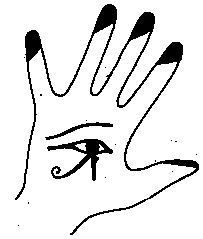
An Eye of Horus
The back of the hands is suitable for more decorative symbolic work, as they will be on display at all times; again, the stain should be quite deep but will wear off quicker the more the hands are immersed in water or detergent. The designs here can be much more intricate and sinuously weave up the arm; a perfect example would be a serpent, commonly used for rising consciousness or divine wisdom.
Fingertips and fingernails are other areas that stain beautifully, but be aware that hennaed nails stay hennaed for several months—they are made from the same protein as hair and are therefore very porous. However, designs on these areas can look stunning and are perfect for protective spells whereby the energy is flowing from the fingertips and deflecting the negative energies away from you. If you don’t want to henna the whole nail, you could stencil a small symbol onto one or more nails.
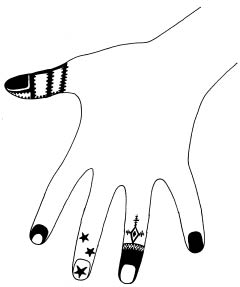
An example of stencilled nails
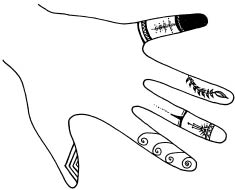
Delicate traceries around the fingers offer a simple yet potent area for applying henna symbols—circles or rings offer protection and/or convey divine or harmonious consciousness.
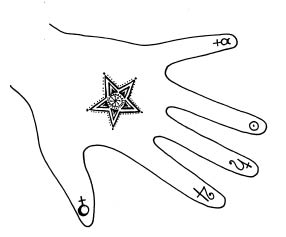
In astrology, the fingers relate to five planets:
• Thumb—Venus
• Index finger—Jupiter
• Middle finger—Saturn
• Ring finger—Sun (also known as the “heart” finger, as people used to believe that it was connected by a nerve or vein to the heart, hence the use of the left finger being used traditionally for the wedding ring)
• Little finger—Mercury
Wrist and Lower Arm
These areas do not stain quite as dark as the hand but still offer a suitable site for weaving traceries, “bracelets,” or “arrow”-style designs. Circles, bands, vines, and Moroccan-style Berber patterns all look beautiful on the arm or wrist and can be used for protection, spiritual direction, or general health spells.
Upper Arm and Shoulder
A perfect spot for delicate or very bold “armband” designs. The stain may not be as dark as the hand, but it is a great area for making a statement. On the upper arm, use spirals, vines, or a Celtic band; for the shoulder, go for symbols of strength and vitality like a flaming sun or a phoenix.
Back and Shoulders
With such a large area, you have the perfect canvas for applying a work of art; obviously, you would need a henna “buddy” to help you with this, as it is impossible to henna your own back! One of the most powerful designs you could use on the back would be the Tree of Life. This ancient symbol can be traced along the spine and contours of the back using an intricate, almost floral design replete with leaves and fruits, or you could use the more geometric Kabbalistic version depicting the ten Spheres, or Sephirot. This design would be used for deep spiritual work or for helping to achieve enlightenment via the branches of wisdom.
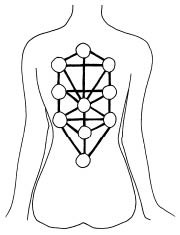
Tree of Life on the back
Legs and Ankles
Depending on your skin type, the intensity of the stain can vary; it is easier to shave your legs before applying the henna so that the area is smooth. As legs represent solidity and strength, use this area for courage, growth, and grounding spells—spiral designs, columns, or strings of symbols (such as stars, hieroglyphs, or calligraphy) are good.
Ankles can be used in a similar way to the wrists—circles, bands, and spiraling flowers or vines are perfect designs to symbolize strength and growth.
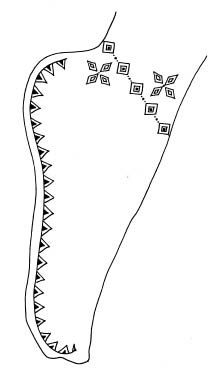
Example of ankle and foot designs
Soles of the Feet
The soles of the feet symbolize the point whereby we connect with the earth, and this area can be used for any spell that needs a grounding or solid result but can also be used for strong protection against negative influences that may be picked up from our surroundings as we walk. It also represents our will; in antiquity, stepping with the left foot first over a threshold was seen as bad luck, whereas using the right foot would bring good fortune.
Use strong, bold designs, maybe even simply covering the entire skin with henna like the sole of a shoe, for the sole of the foot is often neglected. Not only will the henna nourish the skin, but it will also make you feel as if the wash of deep colour is somehow rooting you to the ground.
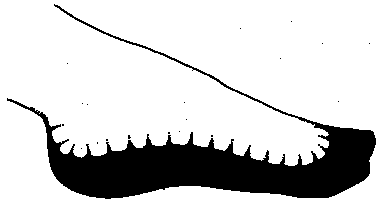
Henna is also very good for cooling the feet and was originally used to protect the feet from the scorching heat of the sun-baked ground or for cooling the body if suffering from heat exhaustion.
The henna will stain the soles very darkly (apart from the arch, which will be slightly lighter) and so will last longer than more exposed areas.
Top of the Foot
This area is wonderful to decorate; you can choose a lacy and intricate pattern like the Indian brides, a strong geometric design of the Berbers, or even a “henna shoe” like babouches (Moroccan slippers)! Use this area of the body as a celebration of your path in life—wherever you walk is your destiny. There is a saying that you should “walk your path so that flowers grow in your footsteps”—meaning that everything you do in life should create something beautiful. Designs for the top of the foot can be lighthearted vines, flowers, or stars. Equally, the design can be a reminder to watch where you walk, so be sure to include a protective or strengthening motif as well.
Neck and Décolletage
The skin on these areas does not always produce a very dark stain and tends to exfoliate quite quickly, but it is a beautiful area to add delicate designs to complement the curves or arcs of the neck and collarbone. It may be difficult to henna oneself here, but it is a good canvas for some vines, spirals, or other motifs that signify growth or spirituality.
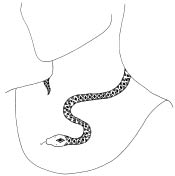
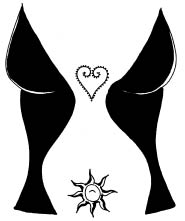
Examples of a snake neck design, top, and heart and solar plexus designs, bottom
Breasts
The breast or heart region is the perfect area for love or passion spells—you could even get your lover to henna a personal design to show how much they adore you, or vice versa! The motifs you choose can be lighthearted or very meaningful and should be applied with much love and due caution. The name of your beloved in any chosen script or language is a potent design, as are any symbols including hearts, triangles, shells, flowers, sigils, or circles.
Solar Plexus
The solar plexus is the region between the bottom of the sternum and the belly button, and it is a great area to apply healing, health-promoting designs or ones for psychic awareness. Associated symbols would be the sun, spirals, labyrinths, or other circular shapes. For inward power, a clockwise spiral would be appropriate, whereas for projecting energy outwards, use one that turns anticlockwise.
Belly
You may find applying henna to the belly to be quite difficult, as you cannot bend or twist without messing up the design; this is where a henna buddy comes in useful, and you need to be prepared to recline for some time while the henna dries. However, designs on the belly or around the navel are very potent, and even if you only manage a small one, it will be not only beautiful to look at but a very powerful talisman.
This area corresponds to the sacral chakra and is an important area for self-esteem and self-respect. It can also be used for healing the organs connected with the abdominal area such as the bowels, ovaries, womb, bladder, and kidneys. Use sensual or bold designs, depending on your intent—weave flowers or vines around the contours of your belly or belly button for soothing or connecting with your feminine energies, or strong, bold designs such as a flaming sun to symbolize self-worth and liberation. If you are pregnant, celebrate the last months with a burst of pattern on your bump.
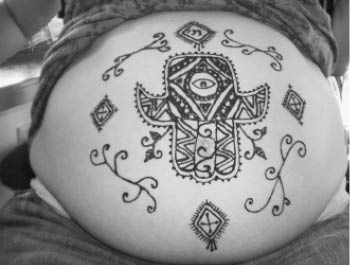
© Maggie Johnston
The Hand of Fatima is a potent symbol to protect against the evil eye, and it imbues good luck and blessings on the wearer
Common Symbols:
Their Meanings and Uses
Use these symbols and their meanings to inspire you to create your magical henna designs. For inspiration, look at designs in other henna, history, or pattern books, clip art libraries, or online.
Acorn: A symbol of good fortune, power, youthfulness and prosperity. A seed of the mighty oak, use this symbol for all small projects that you wish to grow.
Almond: A shape often used in decorative art. As a soft nut within a hard shell, almond represents the essential spirit hidden within.
Alpha (a): The first letter of the Greek alphabet, meaning “beginning.” Alpha symbolizes the primeval creation.
Alpha and Omega (a and W): The first and last letters of the Greek alphabet, the “beginning” and the “end” respectively, which represent totality and the completeness of God.
Anchor: Hope, consistency, and fidelity.
Angels: Protective and divine presence.
Ankh: The ankh is an ancient Egyptian symbol of a looped cross, symbolizing life and fertility. One of the oldest and most popular symbols used by the Egyptians, it was often depicted in the hands of gods, goddesses, and pharaohs, showing the key to immortality and the power of the Divine. The ankh promotes longevity, the immortality of the soul, and fertility, and offers a link to divine powers.
Ant: Fertility and diligence.
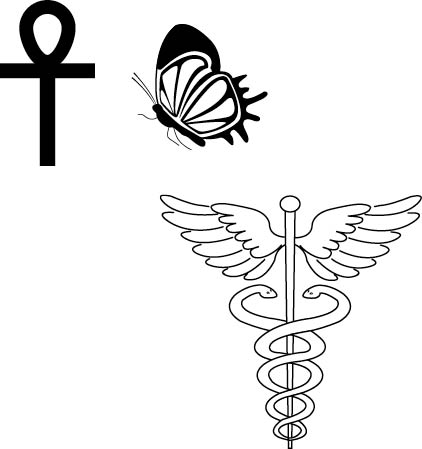
Clockwise from top left: ankh, butterfly, caduceus
Apple: A symbol of fertility, love, and eternity. In the Celtic tradition, it represents spiritual knowledge, due to the inner image of the five-pointed star of the seeds when cut horizontally.
Arrow: A symbol of power and protection, the arrow also symbolizes the rays of the sun and light. It can deflect negative forces when depicted as an outward-projected symbol. In Buddhism and Hinduism, the arrow represents the syllable OM coming from man, who symbolizes a bow—therefore, the arrow journeys from ignorance (the ego) to merge with enlightenment (the Divine).
Axe: A symbol of destruction, therefore useful for protection when something needs a powerful “clearing” action.
Bamboo: Used for good luck or as a symbol of the steps of enlightenment attributed to the knots and sections of the plant.
Bat: A symbol of good luck, intelligence, or sexuality; as a cave dweller, it sometimes symbolizes immortality. Due to its dual nature of being half bird/half mammal, alchemically it represents the hermaphrodite, or duality of the soul.
Beans: Fertility, abundance, and good fortune.
Bear: A masculine (yang) symbol of power and strength; also, alchemically represents the darkness and the prima materia (primal matter, or source of all).
Bee: Used by the ancient Egyptians as a symbol associated with the sun and the human soul, the bee is also a symbol of rebirth, resurrection, diligence, and cleansing.
Bell: The symbol of a bell has been used for centuries to ward off the evil eye and banish malicious spirits. It also represents cosmic harmony. In Islamic traditions, the bell is looked upon as an echo of the voice of God, indicating his omnipotence and allowing the soul to rise above the mundane material world.
Birds: Birds symbolize the link between heaven and earth and are viewed as mediators and embodiments of the soul (as in the Egyptian religion, whereby the ba, or soul, is represented by a human-headed bird). Different types of birds have slightly differing meanings, but almost all birds are considered divine mediators.
Butterfly: A symbol of femininity. Two butterflies signify a happy marriage. The butterfly is also universally recognized as a symbol of liberation, metamorphosis, rebirth, and new beginnings.
Caduceus: A herald’s staff or wand of the Greek god Hermes (Roman Mercury). It depicts two serpents entwined around the staff, their heads facing each other, and sometimes the serpents are winged. Not to be confused with the wand of Asclepius, the Greek god of healing and medicine, the caduceus is sometimes interpreted as a symbol of fertility, but more often than not it represents balance and equality. In alchemy, it symbolizes the union of opposing forces.
Carp: Strength and stamina. In Japan and China, the carp represents longevity and good fortune, and it is often depicted being ridden by the immortals.
Cat: The symbol of the cat varies; in early years, it was seen as unfortunate except in ancient Egypt, where it was revered. Modernly, it is seen as a symbol of good fortune, wisdom, and protection.
Chai: A Jewish symbol consisting of the Hebrew letters Het (h) and Yod (y); when written as Chai (yh), they mean “living” or “life.”
Chain: Symbolizes attachment or connectivity; often a symbol of the connection between heaven and earth and the uninterrupted flow of energy from the Divine to humankind.
Chalice: See Cup.
Child: Innocence and simplicity; a symbol of new beginnings and boundless possibilities.
Chrysanthemum: In Asian countries, it is a symbol of longevity and happiness; also associated with the sun due to its “rays” of petals.
Circle: A symbol of eternity and unity, as it always leads back to itself; it also represents absolute perfection, symmetry, and a reflection of the micro/macrocosms. Use for protection, enlightenment, and spiritual harmony rituals.
three intersecting circles: Symbolizes the trinity of many spiritual paths. Use this design to help connect with any trinity of deities—e.g., Amun, Mut, and Khonsu; Isis, Osiris, and Horus; or the Father, Son, and Holy Spirit.
circle within a square: In the Kabbalah, this represents the spark of the Divine hidden within matter. Use this symbol to connect with your higher self and the Divine.
circle with dot in middle: A symbol of the sun and also of the perfection of humankind. This symbol is useful for all purification, protection, and spiritual progression rituals.
concentric circles: Also known as the seed of life and the flower of life, many intersecting circles are sacred geometry and represent the spiritual creation and the evolution of humankind.
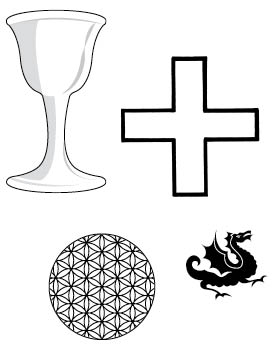
Clockwise from top left: chalice, cross, dragon,flower of life (concentric circles)
Clouds: A symbol of spiritual transformation in China, clouds also represent the unseen realm of the gods. Use for enlightenment or communication with the Divine.
Clover: An ancient Celtic magical symbol of vitality and growth, and a symbol of the Trinity in the Middle Ages. Generally thought of as a symbol of good fortune, especially the four- and five-leaf clover. Going clockwise from the left side of the stem, the four leaves represent fame, wealth, love, and health; use for luck, wealth, and good fortune.
Cockerel: A masculine symbol associated with virility, fire, and the sun—also of vigilance, protection, and the power of light over darkness. As a bird, it is also a messenger of the gods.
Column: A symbol of strength representing the connection between earth and the sky (heaven). Can also represent the human body and is linked to the concept of the Tree of Life. Incorporate this design for gaining strength and wisdom and a feeling of connectedness with your community and the spiritual realms.
Cone (also see Triangle): A symbol of spiritual development, leading from the mundane/base to the peak of enlightenment. Also linked to fertility due to its association with the goddesses Astarte, Ishtar, and Aphrodite.
Corn: Prosperity and happiness. Associated in some cultures with the sun and the creation of man.
Crescent (also see Moon): The half moon in its widely used symbolic form—derived from the Latin crescere, meaning “to grow”—is attributed to the waxing, or increasing, moon. The waxing moon is indicated by the “horns” of the crescent facing left, and the waning (decreasing) moon is depicted with the horns facing right. One of the most ancient symbols known to humankind, the crescent represents the feminine and is associated with many goddesses of varying cultures. The crescent is often paired with a star or as a pair of crescents flanking a full moon, which symbolizes the Triple Goddess of the Pagans. It represents the moon in astrology and the metal silver in alchemy.
Cross: Another ancient symbol that has many variants. It symbolizes the number four (the four cardinal directions or four quarters) and is used in geometry the world over—the Greek cross is the floor plan of many Byzantine churches, whereas the Latin cross is emulated in churches and cathedrals across the globe and is most well-known as a symbol of the cross of Christ. It represents a “crossroads” either literally or spiritually, symbolizes the intersection of heaven and earth, or indicates the dynamic of masculine (vertical) and feminine (horizontal). It also symbolizes the equinoxes and solstices. The cross placed within a circle represents the perfect human.
Cube (see also Square): Represents the element of earth, solidity, and firmness. Use for grounding and healing.
Cup/Chalice: A symbol of abundance, also a vessel for receiving divine blessings and immortality of the soul. Use for deeply spiritual work or for accepting the grace of (your individual) god.
Diamond: Purity and spirituality. In Morocco, the diamond is a powerful symbol against the evil eye. Use for all protection rituals and to deflect negative or malicious intent.
Disk (see also Circle): A symbol associated with the sun; with wings, it represents the path of the sun through the heavenly realms.
Dolphin: Associated with water/the sea; the dolphin is a spiritual guide and protector.
Dove: Temperance, purity, and the Holy Spirit. The dove is sacred to Ishtar, Aphrodite, and other goddesses of love and fertility; it is also a symbol of peace through reconciliation.
Dragon: An ambiguous symbol, the dragon can represent many things in different cultures. In China and Japan, the dragon is believed to bestow good fortune and fertility, and it is a protector against demons. In Hinduism and Taoism, it can produce the elixir of life and represents immortality. However, in other cultures, it is a symbol of evil or the battle between our ego and our regressive forces. It also symbolizes a duality of the masculine, active yang energy but with the watery forces of yin—an alchemical, primeval blend of opposites. A powerful symbol, use dragon for good luck, protection, fertility, balance, or strength.
Dragonfly: These delightfully colourful and somewhat mystical creatures are a symbol of transformation and cutting through the binds of illusion. They also represent joyful freedom, beauty, and direction. Use for any work where you feel trapped by false illusion and wish to “fly free” and be transformed.
Duck (also see Bird): In China, a pair of ducks symbolizes marital stability and bliss. Use for harmony and marriage rituals.
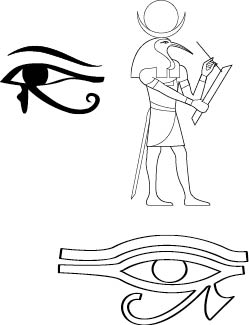
Clockwise from top left: left Eye of Horus, Thoth, and right Eye of Horus
Egg: In universal creation myths, the egg represents a primary part of the primeval birth of the world. The egg floated in the waters that were created from chaos and issued forth the cosmos and the elements; various deities were depicted being born from the egg. Therefore, it is seen as a symbol of perfection, birth/rebirth, or the alchemical prima materia from which the philosopher’s stone was hatched. Use for fertility, rebirth, or “connecting to the source” rituals.
Eye: Associated with the sun, light, spirit, inner vision, and protection. Use for all magic where you desire wisdom, prosperity, spiritual protection, good health, or clairvoyant powers.
The Eye of Horus—or udjat, the ancient Egyptian “all-seeing eye”—was traditionally believed to give the deceased the power to see again. The right eye represented the sun and protection (Re), and the left eye, the moon and magic (Thoth). It was also a system of sacred geometry and mathematics.
The evil eye is a very prominent concept in the Middle East, whereby the casting of a look or glance from someone (or something) who means you harm or is jealous of you can be very damaging. This is basically the premise for sympathetic “black” magic—of being cursed or hexed—and is a worldwide belief. There are many different amulets or symbols used to protect oneself from the evil eye, one of which is the predominantly Turkish nazar, a ball or disk usually made from glass with concentric rings of blue and white circles that represent the eye and therefore protect against any negative influences by bouncing the evil back to the person who cast it. These amulets are often seen in Mediterranean, Islamic, and Middle Eastern countries.
The Eye of Providence, or “all-seeing eye”—an eye set within a triangle and often surrounded with rays of light, or glory—is a symbol of the omnipresence of the Divine. Closely aligned with the Egyptian udjat, it is now universally linked to Freemasonry and the ideal of a Supreme Being watching over humankind and making the Mason aware that every thought and deed is observed, which helps them strive to be moral men.
Faeries: Symbols of the spirit of nature that must be treated with caution. Use the image of a faerie to draw good fortune towards you and to show your respect for the earth.
Feather: Often associated with the sun, the sky, and material or spiritual growth. The feather of Ma’at is the symbol of truth, order, and justice, as worn by the Egyptian goddess of the same name, who presided over the weighing of the heart in the Hall of Judgment.
Fig/Fig Leaf: Symbolizes fertility, abundance, knowledge, and nourishment. Use for any magic that requires joyous bounty.
Fire/Flame: Represents purification and spiritual rebirth (see Phoenix). Use fire or flames in a design when you wish to renew, purify, strengthen, or protect yourself.
Fish: Closely associated with water, its life source, the fish is symbolic of life, rebirth, and fertility. Symbolic of the astrological sign of Pisces, the fishes represent the passive, feminine, and moveable.
Fleur-de-lys: A symbol of the Trinity, of purity, and of martial power.
Flower: Associated with the sun, rain, and femininity. The flower, or blossom, represents achievement, the ability to absorb knowledge, and humility. Choose your favourite flower and use it to connect you with the manifestation and beauty of nature.
Frog: Another ambiguous symbol, depending on culture; in China and Japan, the frog augers good luck, whereas in the Bible, frogs were seen as unclean or evil. In Egypt, they represent fertility and immortality. In shamanic traditions, frogs are seen as a symbol for spiritual cleansing. Use for cleansing, good fortune, or fertility motifs.
Grapes/Grapevine: A symbol of abundance, rebirth, and life itself. This design could be easily incorporated on an arm, leg, or back.
Hammer: Symbolizes power, strength, justice, and reasoning. Associated with the Norse god Thor and revered in Celtic traditions, this is a very strong fire symbol to use in spells for legal or authoritarian matters or direction of will.
Hand: The hand is used symbolically and practically in many different ways—to make gestures that are protective, offensive, or victorious; as a handshake to offer friendship, make something binding, or to indicate openness. Symbolic or magical hand gestures are used in traditional dance in Indian cultures and in Buddhist traditions for meditation. The left hand is commonly seen as feminine and passive, whereas the right is masculine and conveys activity or blessing. The use of the hand as a design symbol indicates power, divine blessing (the hand of God), or, in the form of the hamsa (the Hand of Fatima or Miriam—see page 61), as a powerful protective motif.
Hare: A powerful fertility symbol associated with spring, the earth, and renewal. Also symbolizes fleetness, agility, and sexuality.
Heart: Generally regarded as a symbol of love but also associated with the will, spirituality, and the centre of reasoning. In ancient Egypt, the heart was viewed as the central point for the life force, the will, and the mind. In Islam, it is identified with contemplation and spiritual love, and in India, it is perceived as the place of contact between humans and God (Brahma). Use for all love spells but also for a deep connection to the Divine.
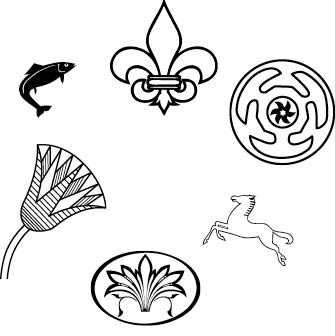
Clockwise from top left: fish, fleur-de-lys, Hecate’s wheel, horse, Eastern lotus, Egyptian lotus
Hecate’s Wheel: A labyrinth-like symbol associated with the Greek goddess Hecate. It represents her triple aspect of Maiden, Mother, and Crone, and possibly is linked to Hecate’s early role as guardian of crossroads, before her gradual change to goddess of magic. Use this symbol as a connection to your female roles and for any spell that involves taking a firm direction towards a goal.
Hieroglyphs: Derived from the Greek to mean “sacred writing” and used as stylized pictures by the ancient Egyptians to form their alphabet.
Horn: Power and fertility. It is an ambivalent symbol that is feminine in its lunar aspect (shaped like a crescent) or masculine in its phallic shape. Also represents abundance when depicted as a horn of plenty. Use as a motif to create balance between the masculine and feminine aspects of the self or for a powerful protective symbol.
Horse: Fertility, power, energy, and freedom. Associated with Celtic goddesses Epona and Rhiannon but equally seen as a masculine symbol of virility and strength. Use as a balance of male/female energies and for strength and stamina.
Horseshoe: A universal symbol of good luck, often used in Egypt with “horse beads” to ward off the evil eye. Incorporate in designs to add extra protection against negative energies.
Hourglass: A symbol of the fleeting passage of time. Useful incorporated into designs as a reminder to make the most of our time on earth.
Ibis: A bird sacred to Thoth, the Egyptian god of magic and writing. Its curved beak represents the lunar energies. Use in spells to invoke the wisdom of Thoth in all his aspects.
Ivy: As an evergreen, it is a symbol of immortality but also one of fidelity and friendship. In ancient Greece, it was customary to present the bride and groom with a bunch of ivy. Use in all spells involving friendship, fidelity, or eternal love.
Jackal: Represents Anubis, the ancient Egyptian god of embalming and the afterlife. He assisted with the weighing of the heart in the Hall of Judgment and was the guardian of the underworld. Use for any work involving astral projection or travelling through the spirit world. Jackal is also a powerful protection design to apply if you are to undergo a general anesthetic.
Key: A symbol of liberation and freedom, also for success and unlocking hidden knowledge and wisdom. Use for any work involving new or unknown situations or for gaining access to secrets or hidden wisdom.
Knife: A symbol of masculine, active energy; also for cutting through negative vices or thoughts. Use for banishing rituals or for evoking strong masculine energy.
Knot: Symbolizes connectivity or a link to greater powers for protection or to bestow immortality. In ancient Egypt, the “Knot of Isis” was a common amulet, similar to the ankh, worn to encourage a long life. It is also connected to love and marriage; in some cultures, the hands are knotted together either symbolically or literally. It is used as a protective symbol in Islam; the men often tie knots in their beards to ward off evil. The action of untying or cutting through a knot is also symbolic of opening oneself up or overcoming problems. Use for any work that involves protection, ridding bad habits, or strengthening bonds.
Labyrinth: Associated with initiation rites, use this symbol as a personal quest to enter the spiritual realms and traverse the light and dark worlds or for meditation to reach the “hidden” centre, or God.
Ladder: As a representation of the steps between heaven and earth, incorporate this design to help achieve spiritual progress.
Leaf: A much-used design in henna patterns, the leaf represents happiness and prosperity. When depicted as a branch with leaves, it’s a symbol of community and cooperation.
Letters: Highly symbolic in many cultures, especially within the Jewish Kabbalah. Each letter can be mystically interpreted by its shape, numerical value, and pronunciation. In ancient Greece, much emphasis was put on the seven vowels and their symbolic link with the seven heavenly spheres and the seven sets of stars that moved within them. The vowels were perceived as symbols of spirit whereby the consonants were symbolic of matter; put together within the alphabet, both spirit and matter were blended to create perfection and completeness. In the Muslim world, letters are categorized as being of the four elements—earthy, airy, fiery, or watery.
Write your name or initials in calligraphy or calligraphic style for added power.
Lightning: In its positive form, lightning represents a manifestation of divine, or “greater,” power, fertility, or even phallic energy. In its other form, lightning is a symbol of divine wrath or punishment. Use for potent magic needing divine energy and direction.
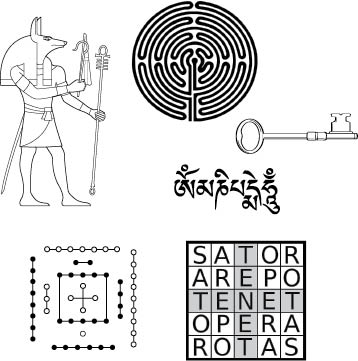
Clockwise from top left: Anubis, labyrinth, key, Om mani padme hum, “Sator” magic square, magic square with dots
Lion: A symbol of strength and power, associated with the sun, the astrological sign of Leo, and the Egyptian goddess Sekhmet. Use this symbol for all work that involves the need for courage, strength, and justice.
Lizard: A light-seeker and therefore symbolic of those who seek spiritual enlightenment; associated with the sun. The lizard is a lovely design to use for any work where you need guidance towards the light of divinity.
Lotus: One of the most ancient and beautiful symbols. The lotus has played a vital role in the spiritual symbolism of ancient Egypt, India, and East Asia. As a flower that follows the natural patterns of the day and night, it was viewed as one of the most sacred plants. In the morning, the tightly closed bud opens only when the sun has risen, and then when the sun sets, it draws itself back under the water to await the light once more. However, not only is it revered for its affinity with the light and dark but also its remarkable ability to live within the mud and detritus of the river, only to emerge each day pure and unsullied. The ancient Egyptians’ relationship with the lotus is evident from its depiction on tombs, temples, and papyri; the flower is featured in several of their creation myths, whereby it emerges from the primeval waters of chaos and opens to reveal the divine one. Its ability to emerge each day with the sun linked it to the sacred, life-giving aspect of the Nile, and it became a symbol of immortality and regeneration. The blue lotus of the Nile (Nymphaea caerulea) is believed to be a narcotic and was probably used in rituals to evoke a trancelike state for meditation or astral projection.
The lotus is also found in the Buddhist and Hindu traditions. Again, it is featured in creation myths and revered for its purity. The eight-petaled lotus is a symbol of the cardinal points and so encompasses cosmic harmony, whereas the thousand-petaled lotus symbolizes the entirety of spiritual revelation. Buddha is often depicted sitting on a lotus leaf or emerging from the flower, and the mantra Om mani padme hum translates as “Praise to the jewel in the lotus, hail!” whereby the jewel relates to the mind/consciousness and the lotus is the heart, the source of love.
Use the symbol of the lotus for any magical work that involves contemplation or meditation upon the source of creation (the Divine), and also for purification, protection, or opening your heart.
Magic Squares: Used as talismans for divination, protection, and longevity for over 4,000 years. Particularly favored by early Arabic polymaths, they became popular in the middle ages in Europe with the growth of magic and mysticism, and Agrippa’s kameas—the term used by medieval and Renaissance magicians to refer to the various magic squares in use during that period—are still used in ceremonial magic today. Numbers are used to correspond with planetary or angelic forces. One of the most widely recognized is the Sator Square, which uses the words SATOR AREPO TENET OPERA ROTAS as a palindrome in a square reading the same top to bottom, bottom to top, left to right, and right to left. It is believed to translate from the Latin as “The Great Sower holds in his hand all works; all works the Great Sower holds in his hand.”[1]
Mandala: Derived from the Tibetan language, mandala is the Sanskrit word for “circle” or “completeness.” It relates to the concentric circular patterns used in Buddhist and Hindu traditions as a meditational tool. The psychologist Carl Jung referred to mandalas as “a representation of the unconscious self”—they are also a symbol of the micro- and macrocosm.
Mistletoe: An ancient Celtic symbol of immortality and good luck.
Moon (see also Crescent): A strongly passive feminine symbol due to the moon’s influence on women’s bodies and the oceans. Representative of all things connected with the female psyche and physical body, fertility, the power of change, good luck, and the unconscious realms. Use for spells involving clairvoyance or dreams, fertility, female protection and health, astral projection, or any work in the spirit world.
triple moon: This is a symbol representing the three phases of the moon as waxing, full, and waning, and also the aspects of the Pagan Goddess as Maiden, Mother, and Crone. Associated with female energies and psychic abilities, this is a traditional symbol often worn by high priestesses. This symbol can help to enhance your feminine energy and psychic abilities; use it for divination and ritual magic.
Nefer: A symbol depicting the heart and trachea, it was originally worn by the Egyptians to represent beauty, goodness, health, and youthfulness.
Numbers: As symbols, the numbers can be used literally or as the amount of other images in the design, e.g., six hearts.
zero: All, everything, the absolute.
one: Individuality, yang (positive, masculine), aggressive, new beginnings, and purity.
two: Balance, union, yin (passive, feminine), receptivity, duality, and relationships.
three: Creativity, fecundity, direction, and new ventures; also past, present, and future.
four: Stability, solidity, grounding, persistence.
five: Motion, travel, unpredictability, change.
six: Harmony, love, truth, balance, enlightenment.
seven: Magical influence, activity, consciousness.
eight: Power, money, success, determination, evolution.
nine: Highest level of achievement, attainment, intellect, and power to change.
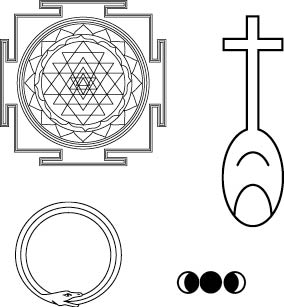
Clockwise from top left: mandala, nefer, triple moon, ouroboros
Oak Leaf: As a part of the mighty oak tree, the leaf symbolizes strength, masculinity, and tenacity. Use for rituals that need strength, fortitude, and incorruptibility.
Octagon: The eight-sided shape represents universality and perfection. In the ancient Egyptian religion, there were eight spheres to ascend to, which included the seven planets and the eighth sphere of perfection.
OM (also AUM): The sacred syllable used by Hindus, Buddhists, and Jains to represent, in part, the three stages of life or the all-encompassing entity that is God. Used as a meditational tool and at the beginning and ending of prayers or readings from the Vedas, the sacred texts of Hinduism. The sacred Sanskrit scripture, the Katha Upanishad, describes the OM: “The goal, which all Vedas declare, which all austerities aim at, and which humans desire when they live a life of conscience, I will tell you briefly, it is Aum.”
Use the symbol ( ) to meditate on as a visual reminder of the all-encompassing nature of the Divine and our role within the world from birth to death.
) to meditate on as a visual reminder of the all-encompassing nature of the Divine and our role within the world from birth to death.
Ouroboros: A very ancient symbol of a serpent eating its own tail, the name ouroboros is derived from the Greek word meaning “tail swallower.” Its origin is most likely Egypt, where it was used as a sign of the cycle of life, regeneration, and the passage of the sun god on his daily travels between the light and the dark of day and night. In alchemy, the ouroboros represents Mercury and the process of purification, renewal, and immortality. Use in all workings to empower you for the understanding of life and death, and for purification and spiritual regeneration.
Owl: Knowledge and the ability to penetrate the spiritual darkness to understand our higher nature. Sacred to the goddess Athena, the owl also brings good luck. Use in spells where you need to gain spiritual knowledge of those things hidden to you.
Peacock: A symbol with varied meanings but universally known as a solar symbol and one of immortality and beauty. However, the negative symbolism is that of pride and vanity. In India, it is a common motif, where it is often depicted being ridden by various deities. Use for spells involving spiritual beauty and the healing power of the sun.
Pear: The pear is often seen as a sexual symbol, of fertility and fecundity, representative of the female form. Use in spells to create a fertile ground for any physical or personal projects but also to encourage the “fruit of the womb” (baby power)!
Phoenix: Seen as a sacred bird in many traditions, the ancient Egyptians named it the benu bird, and it appeared in several different forms. It was associated with the creator sun god, the daily course of the sun, and the renewal of life, as experienced by the yearly inundation of the Nile that produced new and fertile life. This concept was adopted by the Greeks and Romans and eventually by the church fathers, who took on the phoenix as a symbol of regeneration, the bird regularly consumed by fire to resurrect itself from the ashes. Use this beautiful bird as a symbol of the triumph of life over death, of spiritual rebirth and immortality of the soul.
Pig: A potent fertility symbol since antiquity due to its amazing capacity to breed, the sow is often associated with earth-mother-type goddesses. Generally perceived as a symbol of happiness, good fortune, and fecundity, although in some cultures it is seen to represent gluttony, lack of chastity, or plain ignorance. Use in spells for fertility, abundance, and to promote good luck.
Pine Cone: Used for millennia as a symbol of fertility.
Plants: All plants are symbolic of growth and constant change; they are representative of the ability to thrive from earthly goodness and as such encompass the four elements. Use a plant design to create unity and to build a relationship with all the good things that our planet can offer for our nourishment and survival—earth, air, fire (sun), and water.
Pomegranate: Like other seed-bearing fruit, the pomegranate is a symbol of fertility and, because of its sensuous flesh, femininity and sexuality. Its redness is associated with blood, and so it also represents the cycle of life and death. Use as a symbol to celebrate feminine beauty and sexual maturity, and also as a potent protection against infertility.
Poppy: Sleep and forgetfulness. Use in a design to help overcome worries and trauma or to assist in powerful dreams.
Quince (see also Apple): In ancient times, the quince was associated with love, happiness, and fertility. It is possible that Aphrodite’s “apple” was, in fact, a quince, for it was common for Greek women to bring the fruit into the home of their husband on their wedding day to guarantee a happy and fertile marriage.
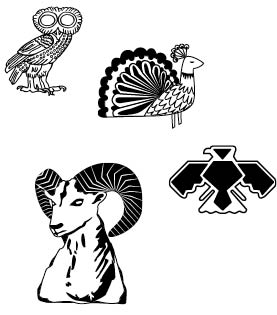
Clockwise from top left: owl, peacock, phoenix, ram
Rainbow: Symbolizes union between the earthly realm and the heavens and the connection between humans and the Divine. Use this symbol for spells that involve spiritual unity and the desire for a better world.
Raindrop: Another fertility symbol due to the ability of rain to encourage growth. Use stylized raindrops in a design for fertility and hope spells, whether for ideas, projects, or babies.
Ram: Attributed to the astrological sign of Aries or Knum, the Egyptian god of creation, the ram is a potent strength and fertility symbol.
Rhombus: Due to its shape being symbolically suggestive of the female genitalia, the rhombus is a sign of feminine sexuality and fertility.
Ribbon: Symbolizes binding or releasing. Use for marriage or handfasting (or, conversely, breaking up or divorce), or for legal- or love-related designs.
Right and Left: The right side is generally seen as masculine, active, and just, whereas the left is passive, feminine, and merciful. However, in some traditions, the left is associated with evil or unluckiness and the right with morality and spirituality, hence the ancient bias against left-handed people.
Ring: Another symbol of eternity due to a ring having no beginning and no end. A symbol of unity, fidelity, or authority similar to the circle or the eye, the ring has properties that protect against negative or malevolent forces. Use for love, marriage, devotion (mental, physical, or spiritual), and protection spells.
River: Symbolic of impermanence and fluidity but also of continual renewal. The merging of rivers into the sea represents the unity of all things. Use fluid, streaming lines in your design to reflect the passage of time but also the beauty of letting things wash over you. In China, they encourage people to “be like water”—meaning to flow around all that comes in your way.
Rose: The eternal symbol for love, beauty, and purity. In alchemy, the seven-petaled rose was considered a complex symbol of correspondences or the steps of the alchemical process, and the “rose cross” of the Rosicrucians symbolizes the spiritual Great Work. Use in rituals or spells that involve love (human or divine) or purity of heart in regard to spiritual work.
Runes: An ancient script originally used in Germanic and Celtic tribes before the introduction of Latin. Each rune is representative of a letter and was also used for magical and divinatory purposes. However, the use of runes continued until the fifteenth century, where they were prevalent in medieval Norway.
Salamander: A mythical elemental who was believed to be able to live within fire and remain unharmed, salamanders symbolize how the righteous can remain peaceful even when under attack. Use this delightful creature as a powerful protector should you feel attacked for no reason—mentally, physically, or spiritually.
Scales: Symbolizes justice and balance; also the sign for Libra in the zodiac. Use whenever you need a clear and balanced decision or outcome.
Scarab: Also known as the dung beetle, the scarab was revered in ancient Egypt as khepri, or “he who has come into being,” a symbol of resurrection and solar energy. Egyptians believed the scarab had been created out of a ball of dung, and the action of rolling the dung ball and burying it in the sand to lay their eggs in was deeply symbolic of the daily passage of the sun, the life force of the world. Therefore, the scarab became a deeply symbolic emblem in their religious and daily lives, representing creation, resurrection, and eternal life. Use the design of this endearing but powerful beetle to bring yourself closer to the source of creation, to enhance the routine of your daily spiritual quest, or to symbolize the desire for immortality of the soul.
Scorpion: Aside from being the zodiacal sign of Scorpio, the scorpion was also a highly feared yet revered sacred animal in ancient Egypt. Serqet, the goddess of magic, was depicted as a woman with a scorpion on her head and was both a protective and a punishing deity. Those who she felt were unjust or immoral would be struck by the poison of the scorpion, yet she also gave breath to the justified deceased, allowing them to be reborn in the afterlife. She also protected humans and gods from scorpion stings, snake bites, or other venomous attacks, and she particularly favored and protected pregnant women and children. Use the symbol of the scorpion as a protective design against injustice and maliciousness or to overcome the negative quality of self-destruction.
Sea Horse: An endearing symbol of good luck. In early China, sea horses were perceived as an escort of souls to the afterlife.
Serpent: This creature is probably one of the most revered yet reviled on the planet. Worshipped as a deity amongst some cultures, seen as the personification of evil in others, it certainly has a powerful effect on the human psyche. Its ability to shed its skin and devour other creatures with ease has given the snake an uneasy place in our history that still evokes a response today. Love them or hate them, snakes are a symbol of renewal, hidden power (see Uraeus), and protection. It is also a highly sexual masculine and feminine symbol (for its phallic shape and its copious receptivity, respectively), and it is used as a metaphor for the powerful energy of tantric kundalini, coiled at the base of the spine, which rises through the spiritual centers until unity with the Divine is achieved. The serpent devouring its own tail is an ancient symbol of renewal and the cycle of life and death (see ouroboros). Use the image of a snake for magic involving sexuality, protection, or rebirth.
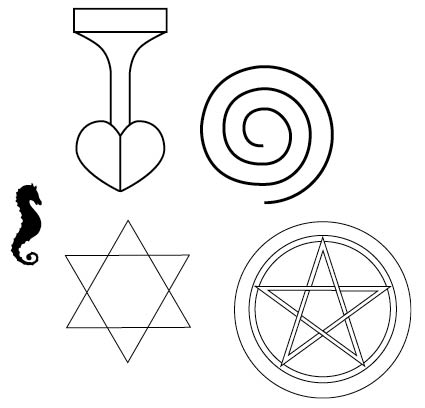
Clockwise from top left: sma, spiral, pentagram, hexagram, sea horse
Shell: A symbol of perfection, for the shape of certain shells reflects the principle of the golden ratio, or the golden spiral, believed to be the measurement used by God for the creation of all things. The scallop shell is sacred to the biblical James, son of Zebedee, and has been worn for centuries by the pilgrims on the sacred Way of St. James to his shrine at Santiago de Compostela in Spain.[2] It is also reputed to be a potent symbol of fertility. Use the motif of the shell for any work involving sacred contemplation on the creation of all things or for interpreting the direction of your life.
Sickle: A symbol of time, death, and the harvest that renews each year; also associated with the crescent as a lunar symbol.
Skull: The skull, aside from its association with death and impermanence, is symbolic of the human microcosm and our relationship with the universal macrocosm. It is also a symbol of transformation. Use the skull when contemplating the transience of our human existence or when you need a reminder to use your time on this earth with respect and purpose.
Sma: An ancient Egyptian symbol representing the lungs. When placed on a mummy, it was believed to give breathing power to the deceased.
Snail: A lunar symbol also associated with the spiral and femininity due to its shape, which is seen as a representation of female genitalia. In some American Indian traditions the snail is believed to help protect pregnant women due to its shape and encasing shell.
Snowflake: Individuality and perfection. No two snowflakes are alike, just as no two humans can be completely alike, but it is the individual nature that reflects the perfect beauty of the creation. Snowflakes embody purity and geometric perfection, a reminder of our spiritual goal to become as pure and perfect as divinity. Use this symbol to celebrate your inner individuality and to invoke purification.
Spear or Lance: A strongly masculine and phallic symbol but also one that implies direction, strength, and power. Use in spells where direct action and bravery is needed or to pierce through negative qualities or vices.
Sphere: Symbolic of the universe and the union of opposites, the self, and the relationship between humans and nature. Its use is similar to that of the circle or ring, but it’s also symbolic of completeness, perfection, and universal divinity and worship.
Spider (see also Web): Power and growth; femininity; mystery, creation and progress. Also associated with the number eight—the number of infinity.
Spiral: Probably the oldest symbol connected to human spirituality and our relationship with the natural and supernatural world. Historically, the spiral has been found in prehistoric sites around the world and is most likely attributed to the cycles of nature and the phases of the moon and its influence on bodies of water and the human condition. It is often used by modern Pagans as a symbol of the Goddess, and when used ritually it can enhance psychic vision, assist in shamanic or astral wandering, and provide spiritual protection.
Square: The four corners are believed to divert evil influences. A symbol of earth and matter, the square is foundational and static, often seen in relation to the circle, which represents the sky or heaven. It is symbolic of the four elements and four cardinal directions, and when placed next to the circle it is seen as the embodiment of pure beauty. Use in conjunction with elemental magic or in protection spells.
Staff (see also Caduceus): An emblem of magical power, knowledge, and healing used to drive away evil. It can also be a phallic symbol. Use the design for direction of magical energy and for healing work.
Stars: Hope and cosmic unity.
pentagram: A five-pointed star usually drawn in one movement. Amongst other things, it represents the five elements of air, fire, water, earth, and spirit, and the figure of a human being. Used for centuries by various traditions, the pentagram can symbolize knowledge and health or can protect the user from evil spirits. The star is normally depicted “point up” when used for magical purposes to represent the power of spirit over the elements, whereas the inverted pentagram represents the descent of spirit into matter and is considered negative or, in the case of Satanic use, evil. The pentagram is often seen enclosed in a circle (called a pentacle), which symbolizes the integration of body and spirit. Use this symbol as a powerful protective design or to create balance between the five elements.
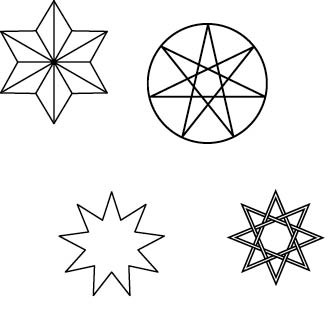
Clockwise from top left: six-, seven-, eight-, and nine-pointed stars
hexagram: The well-known symbol of a six-pointed star formed from two triangles, also called the Star of Solomon or Star of David. It is a symbol of the joining of opposites, the interpenetration of the invisible and visible worlds, and is composed of the alchemical symbols of the four elements. Use this as a design to assist in elemental magic, alchemy, protection, or any work that involves connecting the material with the spiritual.
the unicursal hexagram: The six-pointed star but drawn in one movement as opposed to the two triangles placed one over the other. It is symbolic of supreme self-confidence and the ability to achieve adepthood; in Pagan symbolism, it is representative of the solar system.
heptagram: Also known as a septagram, or seven-pointed star. The number seven is sacred in all the major religions and is mentioned in context in all the holy books; not only does it represent the seven planets, seven levels of heaven, seven days of creation, and seven deadly sins, but it is the number of perfection or completeness. In the Wiccan tradition, it is associated with faeries and often referred to as the “elven star.” Use the heptagram or any seven-sided shape as a powerful protection symbol.
eight-pointed star: Used in many cultures, the eight-pointed star universally symbolizes harmony, balance, and cosmic order. The eight points reflect the four quarters, solstices, and equinoxes. Use this design to connect with cosmic creation, time, and space.
nine-pointed star: A symbol of unity or a representation of the nine planets. Used in the Baha’i faith to represent the nine world religions. This design offers good fortune, spiritual strength, and understanding.
Sun: One of the most important symbols known to humankind due to its light and life-giving properties, for without the sun we would not survive. As it rises and sets each day, it has been revered as a symbol of resurrection and renewal; its daily passage across the skies has been sacred to all cultures. It represents the highest cosmic power, and solar deities from around the world are well known for their creational abilities. Usually attributed to the masculine, active principles, the sun is associated with the metal gold and the element of fire. As a design, the sun is especially powerful for people born under the astrological sign of Leo and for those needing healing or spiritual growth, and for bringing general well-being and good fortune. When depicted as a flaming sun, it is particularly powerful as a protective or banishing symbol. Use for “burning away” negative energies or vices.
Sword: Masculinity, strength, courage, and martial power; also connected with the sun. Due to its sharp blade, it is seen as an emblem of decisiveness, justice, and the ability to cut through evil. Use for all work that involves precision, strength, courage, and the ability to sever negative or destructive thoughts or influences.
Tau: The nineteenth letter of the Greek alphabet:  . Also the Tau cross, named after the last letter of the Hebrew alphabet but believed to have originated with the Egyptians and later used by the early Christians. It is a symbol of resurrection, reincarnation, and redemption; in Egypt, the pharaoh would have the Tau raised to his lips during initiation into the Mysteries. It represents new beginnings and can be used in initiation ceremonies and any rituals that involve a fresh start, or for accessing hidden mysteries.
. Also the Tau cross, named after the last letter of the Hebrew alphabet but believed to have originated with the Egyptians and later used by the early Christians. It is a symbol of resurrection, reincarnation, and redemption; in Egypt, the pharaoh would have the Tau raised to his lips during initiation into the Mysteries. It represents new beginnings and can be used in initiation ceremonies and any rituals that involve a fresh start, or for accessing hidden mysteries.
Tiger: This awesome animal is a symbol of physical strength, spiritual ability, and immortality. Use in any spells that require great focus and courage.
Tree: An ancient and powerful symbol used in many cultures as a representation of nature or divine beings. Deciduous trees symbolize rebirth and resurrection; an evergreen is symbolic of immortality. The shape of the tree represents the union of the cosmos—the roots in the underworld, its trunk on the material plane, and its crown in the heavens. It can be an ambiguous symbol in that it is protective and feminine, bearing fruit and offering shelter and protection; or, conversely, it could be seen as masculine due to its huge strength and the phallic nature of the trunk. The Tree of Life has many meanings, offering abundance and knowledge or, in Kabbalistic terms, representing the process of Creation, of how God made the world out of nothing, and the ten points (known as Sephirot) are the ten attributes of God through which he shows himself and continues to create on both the physical and spiritual levels. It is effectively a map for us to become as or at one with God by reflecting his actions and attributing them to ourselves and our lives.
Triangle: Symbolizes masculinity when tip points upwards, femininity when tip points downwards. Associated with light, fire, the number three, and the Trinity, the triangle often appears with a hand, an eye, a head, or the Hebrew name of God. A protective sign, it is used magically by most metaphysical traditions including Freemasonry (see Eye of Providence, page 81), Hermetics, and in alchemy as the three stages of development (both spiritual and physical). Use the triangle in conjunction with the eye symbol for a powerfully protective design. The sharp corners also deflect negative influence, and it is a reminder of the Divine’s all-seeing and protective nature.
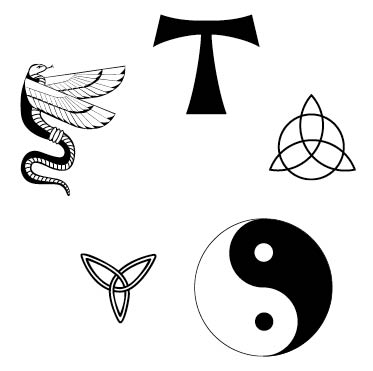
Clockwise from top left: uraeus, Tau cross, triquetra in a circle, yin/yang, triskele
Triquetra: From the Latin meaning “triangle.” In Paganism, it is a Celtic symbol of the Triple Goddess and the god Odin. Associated with the magical aspect of the number three, it represents the three phases of the Goddess (Maiden, Mother, Crone), whereas in Christianity it symbolizes the Holy Trinity. Use this unique design to attune to the power of three—the Goddess, the trinities of ancient Egypt (Amun, Mut, Khonsu or Isis, Osiris, Horus) or of the Christian faith (Father, Son, Holy Spirit).
Triskele or Triskelion: Meaning “three-legged” in Greek, the triskele is a shape made by three interlocked protrusions such as spirals, legs, or horns. It is believed to be an ancient Neolithic symbol representing the power of life and rebirth. In Wicca, like the triquetras (see above), it symbolizes the phases of the Triple Goddess and other triplicities; in Christianity, it represents the Trinity. The horned triskelion, or Odin’s Horn, is used by followers of the Norse Asatru religion. Use the design for connection with the ancient powers of the trinities and for celebrations of life and the promise of rebirth.
Uraeus (see also Serpent): The sacred upright cobra placed on the crown of an Egyptian pharaoh or depicted on a god or goddess as a sign of royalty or divine authority. The cobra was also representative of the goddess Wadjet (who protected the pharaoh), symbolic of the pharaoh’s enlightened spiritual state as a Divine One on earth. Use for achieving spiritual progress and enlightenment and for divine protection.
Web: A symbol that embodies our creative or personal progress in life and the far-reaching consequences of our actions. The symbol of the web makes us think about how we should weave our own destiny, to serve us or trap us. Use this motif whenever you need to contemplate your place in the universe and to give you inspiration and insight into how to apply changes or new directions.
Wishbone: A symbol of good luck and to make wishes and dreams come true.
Yin/Yang: A Chinese symbol representing the two opposing forces in conjunction; also dualities—male and female, dark and light, high and low. Use the symbol to create balance, interconnectedness, and constant interaction, and to highlight the continual link between natural opposites.

